Aomori and more
- Sort by
- Popularity
- Name
-
Edo kiriko cut glass Edo kiriko
- Other crafts
- Tokyo

Edo kiriko is the most famous glass craftwork in Japan. It was originally produced in the city of Edo which was Tokyo's name during the Edo period (1603-1868). Kiriko means "cut glass" so its name means "cut glass from the city…
View more
-
Yuki tsumugi silk Yuki tsumugi
- Woven textiles
- Ibaraki

Yuki tsumugi silk is produced principally in the reaches of the Kinugawa River that straddles the Ibaraki and Tochigi prefectures. The Japanese name Yuki tsumugi comes from the name of a feudal lord during the Kamakura period (1185-1333), Yuki. Al…
View more
-
Kasama ware Kasama yaki
- Ceramic
- Ibaraki

Kasama ware (called Kasami yaki in Japanese) is a form of porcelain produced in the area around the city of Kasama in Ibaraki prefecture. This porcelain has long been considered a traditional souvenir of visiting Kasama Inari shrine (one of Japan&…
View more
-
Tsugaru lacquerware Tsugaru nuri
- Lacquerware
- Aomori

Tsugaru lacquerware (called tsugaru nuri in Japanese) is produced around the city of Hirosaki in Aomori prefecture. Lacquerware has been produced in this region since the middle of the Edo period (1603-1868), but it began to be called Tsugaru lacq…
View more
-
Aizu lacquerware Aizu nuri
- Lacquerware
- Fukushima
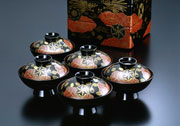
Aizu lacquerware (called Aizu nuri in Japanese) is lacquerware made in the Aizu region of Fukushima prefecture. During the manufacturing process, the craft is classified into round pieces, such as bowls, and flat pieces such as trays or stationery…
View more
-
Echizen traditional Japanese paper Echizen washi
- Traditional Japanese paper
- Fukui

Echizen washi is a Japanese traditional paper made in the basin of the Okafuto river of the Echizen region, Fukui prefecture. Washi is made mostly from the inner bark fibers of plants such as paper mulberry, paperbush, and ganpi. Echizen washi fea…
View more
-
Echizen lacquerware Echizen shikki
- Lacquerware
- Fukui

Echizen lacquerware (called Echizen shikki in Japanese) is produced in the area around the city of Sabae in Fukui prefecture. Lacquer is at the center of life in the Echizen district of Sabae, which is known as the city of manufacturing. The notab…
View more
-
Obori-soma ware Obori soma yaki
- Ceramic
- Fukushima
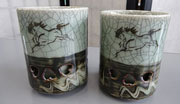
Obori-soma ware (called Obori-soma yaki in Japanese) is a form of porcelain produced around the town of Namie in Fukushima prefecture. This craft uses blue porcelain enamel which is made from locally collected grindstone. The distinctive feature …
View more
-
Aizu-hongo ware Aizu hongo yaki
- Ceramic
- Fukushima
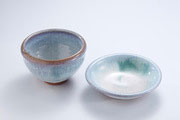
Aizu-hongo ware (called Aizu-hongo yaki in Japanese) is a traditional handicraft from the region of Aizu in Fukushima prefecture with a history of about four hundred years. This pottery, which is thought to have originated during the Sengoku perio…
View more
-
Edo wood joinery Edo sashimono
- Wood, bamboo crafts
- Tokyo
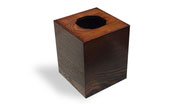
Edo sashimono is a type of wood joinery made in Tokyo with hand-cut dovetail joints and without nails. The word sashimono comes from the process of measuring with a monosashi or woodwork ruler. This craft is characterized by its restrained ornamen…
View more
-
Shodai ware Shodai yaki
- Ceramic
- Kumamoto
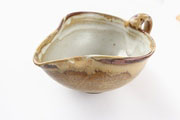
Shodai ware (called Shodai yaki in Japanese) is a form of pottery baked mainly in the northern part of Kumamoto prefecture. This craft is distinguishable because of its simple texture, strong form, and bold design, which is due to the pouring meth…
View more
-
Yamaga lanterns Yamaga toro
- Other crafts
- Kumamoto
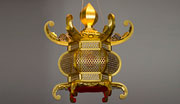
Yamaga toro are lanterns made of washi (traditional Japanese paper) produced in the area surrounding the city of Yamaga, Kumamoto prefecture. For the Yamaga Lantern Festival, an annual summer event, this craft is worn by one thousand dancing women…
View more
-
Echizen ware Echizen yaki
- Ceramic
- Fukui

Echizen ware (called Echizen yaki in Japanese) is a type of pottery produced in the town of Echizen, Fukui prefecture. This traditional handicraft comes from one of the Six Ancient Kilns of Japan which along with Bizen, Tamba, Tokoname, Seto, and …
View more
-
Edo glass Edo garasu
- Other crafts
- Tokyo
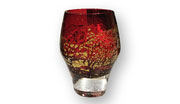
Edo glassware is crafted in the Edogawa, Sumida, and Koto wards of Tokyo. It is also now produced in some areas of nearby Chiba prefecture, but it has been recognized as a local industry of Tokyo. This craftwork uses manufacturing methods, materia…
View more
-
Wakasa lacquerware Wakasa nuri
- Lacquerware
- Fukui

Wakasa lacquerware (called Wakasa-nuri in Japanese) is produced in the area around the city of Obama, Fukui prefecture. It is said to have originated in the early Edo period (1603-1868) when a craftsman serving the Obama domain (now the city of Ob…
View more
-
Murayama-oshima tsumugi silk Murayama oshima tsumugi
- Woven textiles
- Tokyo
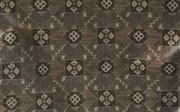
Murayama oshima tsumugi is a silk textile produced in the region surrounding Musashi murayama in western Tokyo. This craft is produced from hand-spun threads pulled from dupioni silk and has kasuri patterns* woven with both warp and weft patterns.…
View more
-
Nara brushes Nara fude
- Writing tools
- Nara
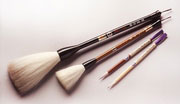
Nara brushes (called Nara fude in Japanese) are brushes produced in and around the neighboring cities of Nara and Yamatokoriyama, Nara prefecture. Nara is considered to be the birthplace of brush making in Japan. The oldest existing brushes in Jap…
View more
-
Tokyo silverware Tokyo ginki
- Metal works
- Tokyo
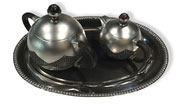
Tokyo silverware (called Tokyo ginki in Japanese) is a form of metal handicraft produced mainly in different wards of Tokyo like Taito, Arakawa, and Bunkyo. It is a traditional craft that has been passed down from the Edo period (1603-1868), and e…
View more
-
Echizen cutlery Echizen uchihamono
- Metal works
- Fukui

Echizen cutlery (called Echizen uchihamono in Japanese) is produced around the city of Echizen, Fukui prefecture. A double layering technique is used for knives and a rotated steel joining technique for sickles. Double layering is a forging method…
View more
-
Edo patterned paper Edo karakami
- Other crafts
- Tokyo
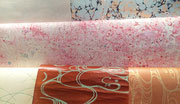
Edo karakami is a type of decorated traditional paper produced in the Bunkyo and Taito wards of Tokyo, as well as Matsudo, Chiba prefecture, and Tokigawa, Saitama prefecture. Designated as a traditional craft by the Japanese government in May 1999…
View more
-
Tokyo fine-patterned dyeing Tokyo some komon
- Dyed textiles
- Tokyo
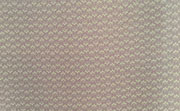
Tokyo fine-patterned dyeing (called Tokyo some komon in Japanese) is a stencil dyed textile produced in different wards of Tokyo like Shinjuku and Setagaya. It was designated as a traditional national craft in 1976. This textile can seem plain fro…
View more
-
Edo bamboo fishing rods Edo wazao
- Wood, bamboo crafts
- Tokyo
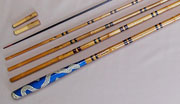
Edo wazao are fishing rods that are produced in the Kanto region, mainly Tokyo and the prefectures of Chiba and Saitama. This craft is named after the Edo lineage of the craftsmen and not the production area of Edo (now Tokyo). It is made from sev…
View more
-
Tama brocade Tama ori
- Woven textiles
- Tokyo
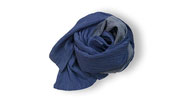
Tama brocade (called Tama ori in Japanese) is a woven silk fabric produced around Hachioji, Tokyo. Since ancient times, Tama ori has been well-known under the name of Hachioji woven fabric. The following five different types of woven fabric are …
View more
-
Amakusa ceramics Amakusa tojiki
- Ceramic
- Kumamoto
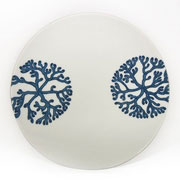
Amakusa ware (called Amakusa Tojiki in Japanese) is a form of pottery or porcelain baked in the Amakusa region of Kumamoto prefecture. The name was newly applied when the craft was designated as a national traditional craft. In Amakusa, where high…
View more
-
Hachio island silk Honba kihachijo
- Woven textiles
- Tokyo
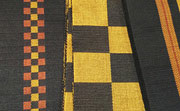
Honba Island Silk (called Honba Kihachijo in Japanese) is produced on Hachijojima Island in Tokyo. The name of this craft derives from a silk fabric with stripe and check patterns mainly dyed in bright yellow called kihachi. Patterns mainly dyed i…
View more
-
Okuaizu Basketry Oku aizu amikumi zaiku
- Wood, bamboo crafts
- Fukushima
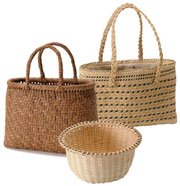
Okuaizu Basketry, called Okuaizu Amikumi Zaiku in Japanese, is basketry produced around Mishima Town, Onuma County, Fukushima Prefecture. As this mountainous area in the Okuaizu region has much snow and farmers are unable to work in the fields in …
View more
-
Echizen traditional chest Echizen tansu
- Wood, bamboo crafts
- Fukui
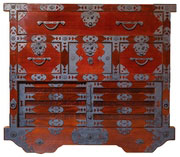
Echizen Tansu are lacquer coated chests of drawers made around Echizen City and Sabae City of Fukui Prefecture. They are mainly made of Japanese zelkova and paulownia, and decorated with iron fittings and lacquer. Japanese zelkova is a hard wood w…
View more
-
Higo inlays Higo zogan
- Metal works
- Kumamoto
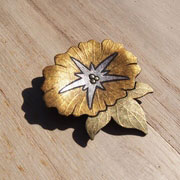
Higo Zogan is inlaid metal work produced in Kumamoto, Kumamoto prefecture. This craft was formerly used to adorn the gun barrels or sword guards of samurai. Today, however, the skills are used to make personal accessories or interior ornaments. Th…
View more
-
Takayama tea whisks Takayama chasen
- Wood, bamboo crafts
- Nara
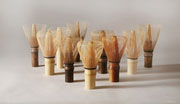
Takayama Tea Whisks, called Takayama Chasen in Japanese, are tea whisks produced in Takayama Town, Ikoma City, Nara Prefecture. Each tea whisk is completely made by hand and they have a top class share in the total Japanese tea whisk market. The t…
View more
-
Wakasa agate craft Wakasa meno zaiku
- Semiprecious stone craftwork
- Fukui
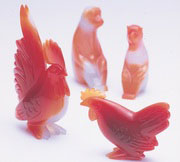
Wakasa Agate Craft (Wakasa Meno Zaiku in Japanese) is agate craftwork produced around the city of Obama, Fukui prefecture. Agate has been appreciated from olden times as one of the seven treasures that decorated the sublime Buddhist paradise ment…
View more

































































































































































































































































































